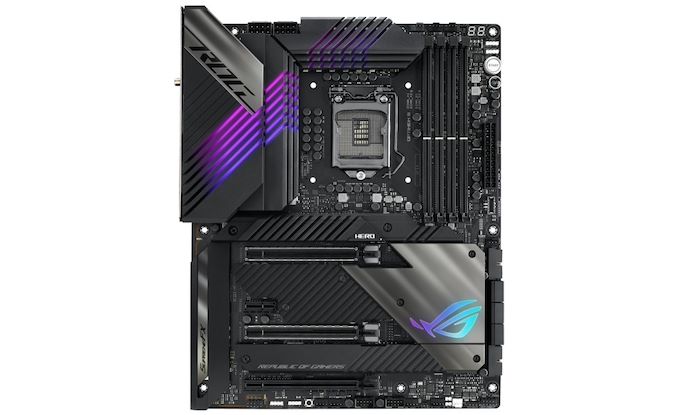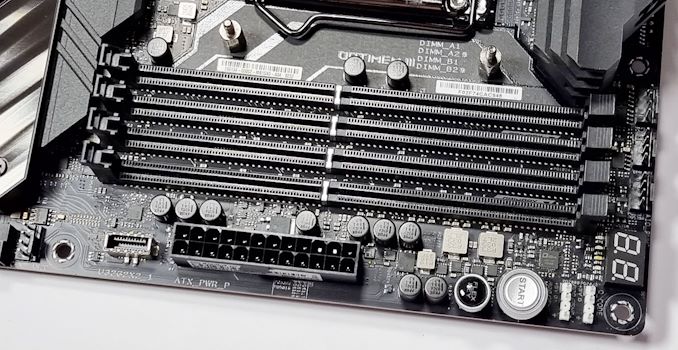ASUS ROG Maximus XIII Hero Review: Everything for Rocket Lake
by Gavin Bonshor on July 9, 2021 9:00 AM ESTVisual Inspection
The ASUS ROG Maximus XIII Hero follows the quintessential modern ASUS ROG design, with large black heatsinks dominating the board's PCB, areas of gunmetal grey accents including on the rear panel cover, and the extended chipset heatsink. There is a lot going on across the board, with multiple areas of integrated RGB LED lighting which includes the rear panel cover, and the rear panel cover. If that's not enough for users, ASUS does include three 3-pin addressable Gen 2 RGB headers, with one 4-pin Aura RGB header. Looking at cooling options, there's a total of eight 4-pin headers, which include two for CPU fans, one for a water pump, one for an AIO CPU cooler, three for regular chassis fans, and one for a high amperage fan.
Looking towards the lower portion of the ROG Maximus XIII Hero, and it has two full-length PCIe 4.0 slots that operate at both x16 and x8/x8, with a full-length PCIe 3.0 x4 slot along the bottom. In the middle of the two full-length PCIe 4.0 slots is a single PCIe 3.0 x1 slot. For storage, there are four M.2 slots in total, with the top slot operating at PCIe 4.0 x4, one PCIe 3.0 x4, and two with support for both PCIe 3.0 x4 and SATA M.2 drives. Each of the M.2 slots includes heatsink coverage, which blends in with the rest of the board's aesthetic. In the bottom right-hand corner are a total of six right-angled SATA ports, with support for RAID 0, 1, 5, and 10 arrays.
Located in the top-right hand corner of the board are four memory slots with support for up to DDR4-5333 memory. Users can install up to 128 GB across four slots, with each slot featuring support for 32 GB DDR4 UDIMMs. In addition to this, is a basic, yet functional overclockers toolkit. This consists of a Power (start) button, a flex key button which users can assign a function in the firmware, as well as a two-digit LED debugger.
The Maximus XIII Hero has a very capable power delivery, which includes an 8-phase (14+2) design which is using teamed power stages and is controlled by an Intersil ISL69269 PWM controller. For the CPU VCore section, ASUS is using fourteen Texas Instruments 95410RR 90 Smart Power stages, which are teamed in pairs for a maximum output of up to 1260 A for the CPU. On the SoC section, ASUS is again teaming its power stages, with two Texas Instruments 59880 70 A power stages. Overall the power delivery on the ASUS ROG Maximus XIII Hero is quite formidable.
Cooling the power delivery is a large and elaborate heatsink, with two heatsinks attached to the large metal rear panel cover. The heatsink combined has a lot of weight and mass to it, and underneath the rear panel cover is an electronic strip that has the rear panel covers integrated RGB LEDs. The imprints on the thermal pads show that the heatsinks are making a sound connection with the power delivery componentry.
Under a metal audio PCB cover is the board's integrated audio componentry. This consists of a SupremeFX ALC4082 HD audio codec, which is rebranded for ASUS by Realtek, with an ESS Sabre ESS9018Q2C DAC. Flanking the HD audio codec is an array of ten gold Japanese Nichicon audio capacitors, and the PCB itself is separated from the rest of the board's components and controllers. It's also worth mentioning that the HD audio codec has an EMI shield protecting it from external static and electromagnetic interference.
The ASUS ROG Maximus XIII Hero has one of the most stacked rear panels on Z590, with lots of premium input and output. Starting with conventional connectivity, ASUS includes dual Thunderbolt 4 Type-C, as well as six USB 3.2 G2 Type-A and two USB 2.0 ports. Networking is also beefed up with dual Intel I225-V 2.5 GbE controllers, and Intel's latest AX210 Wi-Fi 6E CNVi, which also adds support for BT 5.2 devices. Other notable inclusions on the rear panel are five 3.5 mm audio jacks and S/PDIF optical output powered by a premium ROG SupremeFX ALC4082 HD audio codec and ESS Sabre ES9018Q2C DAC pairing. ASUS also includes a BIOS Flashback button, a clear CMOS button, and one HDMI 2.0 video output.
What's in The Box
Bundled with the ASUS ROG Maximus XIII Hero is a wide variety of cables, stickers, and accessories for users to get a system up and running out of the box. The most notable include four black SATA cables, an Intel AX210 Wi-Fi 6E antenna, a user manual and supporting DVD, as well as an M.2 screw installation kit and a fancy ROG keychain.
- User Manual
- Driver installation/support DVD
- 4 x SATA cables
- M.2 Screw kit
- ARGB Extension cable
- RGB extension cable
- Intel AX210 Wi-Fi 6E Antenna
- Q-Connector
- ROG Sticker sheet
- ROG Graphics card holder
- ROG Logo plate stickers
- ROG Keychain
- ROG Thank you card

















28 Comments
View All Comments
Samus - Tuesday, July 13, 2021 - link
Seriously, and I thought AMD platforms were expensive (at least prior to the B550) but Intel is just ridiculous. It used to be their crutch was lower cost of entry, but now they have practically nothing. They are more power hungry, lower performance per watt, more expensive per MOp, and now the boards\chipsets cost more, too.timecop1818 - Friday, July 9, 2021 - link
> There is a lot going on across the board, with multiple areas of integrated RGB LED lighting which includes the rear panel cover, and the rear panel cover.I'm happy to know RGB is limited to just the rear panel cover.
Threska - Saturday, July 10, 2021 - link
Of course so you can blind all the poor people following you with their cheaper boards. But seriously it looks like the big back shroud is the newest trend in motherboards. AMD or Intel, both have it.timecop1818 - Friday, July 9, 2021 - link
> Other inclusions include a pair of premium and high-spec Thunderbolt 4 Type-C ports on the rear panel, which support DisplayPort video input too for users with compatible monitors.What does this mean? The more interesting part of thunderbolt is to be able to transmit DisplayPort video FROM the PC to monitor, so I'm expecting there to be a DisplayPort INPUT connector / header on the motherboard to loop into the external GPU video outputs. Can this board do that? Or is the TB output limited to whatever IGPU is on the processor?
Exotica - Friday, July 9, 2021 - link
There is No dedicated GPU support via thunderbolt, just the igpu. One of the biggest limitations of this expensive $500 board. The z590 vision d has a DP-in foe this purpose.Exotica - Friday, July 9, 2021 - link
for*Spunjji - Monday, July 12, 2021 - link
I'd argue that's not an especially interesting part of Thunderbolt from the perspective of a desktop PC. The high-bandwidth data connection is definitely more of a draw there than display output, given that the GPU already has those attached.weilin - Friday, July 9, 2021 - link
I have this board, there's a few trade-offs this board has that been omitted from the review:1 of the M.2 slots is PCIe 4.0 and has dedicated lanes
1 of the M.2 slots is PCIe 3.0 and has dedicated lanes
1 of the M.2 slots is PCIe 4.0 but shares lanes with the second PCIe 16x slot. (8x,4x,4x setup if the M.2 is present)
1 of the M.2 slots shares HSIO with SATA ports 5-6 (populating this slot will disable those SATA ports)
The PCH PCIe 16x slot (that's electrically 4x) shares HSIO with SATA ports 1-4 (populating that slot with a 4x card will disable the first 4 SATA ports) If this slot runs at 2x then only SATA 3-4 are disabled.
Alistair - Friday, July 9, 2021 - link
Who in their right mind would buy this though? I just checked the local store and you can get the Asus X570 Tuf + Ryzen 12 core 5900X for just $700.lilkwarrior - Monday, July 12, 2021 - link
It's the Tuf series though which can't be compared; the CPU is fundamentally inferior to AMD's so that price isn't surprising.That Tuf motherboard has significant drawbacks when it comes to I/O, especially when it comes to Thunderbolt & etc.